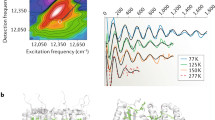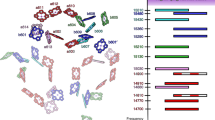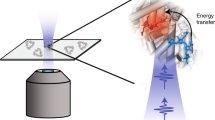Abstract
Femtosecond pulsed excitation of light-harvesting complexes creates oscillatory features in their response. This phenomenon has inspired a large body of work aimed at uncovering the origin of the coherent beatings and possible implications for function. Here we exploit site-directed mutagenesis to change the excitonic level structure in Fenna–Matthews–Olson (FMO) complexes and compare the coherences using broadband pump–probe spectroscopy. Our experiments detect two oscillation frequencies with dephasing on a picosecond timescale—both at 77 K and at room temperature. By studying these coherences with selective excitation pump–probe experiments, where pump excitation is in resonance only with the lowest excitonic state, we show that the key contributions to these oscillations stem from ground-state vibrational wavepackets. These experiments explicitly show that the coherences—although in the ground electronic state—can be probed at the absorption resonances of other bacteriochlorophyll molecules because of delocalization of the electronic excitation over several chromophores.
This is a preview of subscription content, access via your institution
Access options
Access Nature and 54 other Nature Portfolio journals
Get Nature+, our best-value online-access subscription
$29.99 / 30 days
cancel any time
Subscribe to this journal
Receive 12 print issues and online access
$259.00 per year
only $21.58 per issue
Buy this article
- Purchase on Springer Link
- Instant access to full article PDF
Prices may be subject to local taxes which are calculated during checkout




Similar content being viewed by others
References
Scholes, G. D. et al. Using coherence to enhance function in chemical and biophysical systems. Nature 543, 647–656 (2017).
Collini, E. et al. Coherently wired light-harvesting in photosynthetic marine algae at ambient temperature. Nature 463, 644–647 (2010).
Wong, C. Y. et al. Electronic coherence lineshapes reveal hidden excitonic correlations in photosynthetic light harvesting. Nat. Chem. 4, 396–404 (2012).
Engel, G. S. et al. Evidence for wavelike energy transfer through quantum coherence in photosynthetic systems. Nature 446, 782–786 (2007).
Panitchayangkoon, G. et al. Long-lived quantum coherence in photosynthetic complexes at physiological temperature. Proc. Natl Acad. Sci. USA 107, 12766–12770 (2010).
Brixner, T. et al. Two-dimensional spectroscopy of electronic couplings in photosynthesis. Nature 434, 625–628 (2005).
Dostál, J., Pšenčík, J. & Zigmantas, D. In situ mapping of the energy flow through the entire photosynthetic apparatus. Nat. Chem. 8, 705–710 (2016).
Tronrud, D. E., Wen, J., Gay, L. & Blankenship, R. E. The structural basis for the difference in absorbance spectra for the FMO antenna protein from various green sulfur bacteria. Photosynth. Res. 100, 79–87 (2009).
Christensson, N., Kauffmann, H. F., Pullerits, T. & Mancal, T. Origin of long-lived coherences in light-harvesting complexes. J. Phys. Chem. B 116, 7449–7454 (2012).
Chenu, A. & Scholes, G. D. Coherence in energy transfer and photosynthesis. Annu. Rev. Phys. Chem. 66, 69–96 (2015).
Pullerits, T., Zigmantas, D. & Sundström, V. Beatings in electronic 2D spectroscopy suggest another role of vibrations in photosynthetic light harvesting. Proc. Natl Acad. Sci. USA 110, 1148–1149 (2013).
Chin, A. W. et al. The role of non-equilibrium vibrational structures in electronic coherence and recoherence in pigment–protein complexes. Nat. Phys. 9, 113–118 (2013).
Tiwari, V., Peters, W. K. & Jonas, D. M. Electronic resonance with anticorrelated pigment vibrations drives photosynthetic energy transfer outside the adiabatic framework. Proc. Natl Acad. Sci. USA 110, 1203–1208 (2013).
Chenu, A., Christensson, N., Kauffmann, H. F. & Mancal, T. Enhancement of vibronic and ground-state vibrational coherences in 2D spectra of photosynthetic complexes. Sci. Rep. 3, 2029 (2013).
Mančal, T. et al. System-dependent signatures of electronic and vibrational coherences in electronic two-dimensional spectra. J. Phys. Chem. Lett. 3, 1497–1502 (2012).
Reimers, J. R., McKemmish, L. K., McKenzie, R. H. & Hush, N. S. Non-adiabatic effects in thermochemistry, spectroscopy and kinetics: the general importance of all three Born–Oppenheimer breakdown corrections. Phys. Chem. Chem. Phys. 17, 24641–24665 (2015).
Spano, F. C. The spectral signatures of Frenkel polarons in H- and J-aggregates. Acc. Chem. Res. 43, 429–439 (2010).
Schröter, M. et al. Exciton–vibrational coupling in the dynamics and spectroscopy of Frenkel excitons in molecular aggregates. Phys. Rep. 567, 1–78 (2015).
Fujihashi, Y., Fleming, G. R. & Ishizaki, A. Impact of environmentally induced fluctuations on quantum mechanically mixed electronic and vibrational pigment states in photosynthetic energy transfer and 2D electronic spectra. J. Chem. Phys. 142, 212403 (2015).
Monahan, D. M., Whaley-Mayda, L., Ishizaki, A. & Fleming, G. R. Influence of weak vibrational–electronic couplings on 2D electronic spectra and inter-site coherence in weakly coupled photosynthetic complexes. J. Chem. Phys. 143, 065101-11 (2015).
Fujihashi, Y., Fleming, G. R. & Ishizaki, A. Influences of quantum mechanically mixed electronic and vibrational pigment states in 2D electronic spectra of photosynthetic systems: strong electronic coupling cases. J. Chin. Chem. Soc. 63, 49–56 (2016).
Rätsep, M. & Freiberg, A. Electron–phonon and vibronic couplings in the FMO bacteriochlorophyll a antenna complex studied by difference fluorescence line narrowing. J. Luminesc. 127, 251–259 (2007).
Wendling, M. et al. Electron–vibrational coupling in the Fenna–Matthews–Olson complex of Prosthecochloris aestuarii determined by temperature-dependent absorption and fluorescence line-narrowing measurements. J. Phys. Chem. B 104, 5825–5831 (2000).
Saer, R. G. et al. Probing the excitonic landscape of the Chlorobaculum tepidum Fenna–Matthews–Olson (FMO) complex: a mutagenesis approach. Biochim. Biophys. Acta 1858, 288–296 (2017).
Adolphs, J. & Renger, T. How proteins trigger excitation energy transfer in the FMO complex of green sulfur bacteria. Biophys. J 91, 2778–2797 (2006).
Panitchayangkoon, G. et al. Direct evidence of quantum transport in photosynthetic light-harvesting complexes. Proc. Natl Acad. Sci. USA 108, 20908–20912 (2011).
Hayes, D., Wen, J., Panitchayangkoon, G., Blankenship, R. E. & Engel, G. S. Robustness of electronic coherence in the Fenna–Matthews–Olson complex to vibronic and structural modifications. Faraday Disc. 150, 459–469 (2011).
Thyrhaug, E., Žídek, K., Dostál, J., Bína, D. & Zigmantas, D. Exciton structure and energy transfer in the Fenna–Matthews–Olson complex. J. Phys. Chem. Lett. 7, 1653–1660 (2016).
Nitzan, A. Chemical Dynamics in Condensed Phases: Relaxation, Transfer and Reactions in Condensed Molecular Systems (Oxford Univ. Press, 2006).
Kelley, A. M. Condensed-Phase Molecular Spectroscopy and Photophysics 191–214 (Wiley, 2012).
Reinot, T., Zazubovich, V., Hayes, J. M. & Small, G. J. New insights on persistent nonphotochemical hole burning and its application to photosynthetic complexes. J. Phys. Chem. B 105, 5083–5098 (2001).
Jonas, D. M., Bradforth, S. E., Passino, S. A. & Fleming, G. R. Femtosecond wavepacket spectroscopy: influence of temperature, wavelength, and pulse duration. J. Phys. Chem. 99, 2594–2608 (1995).
Johnson, A. S., Yuen-Zhou, J., Aspuru-Guzik, A. & Krich, J. J. Practical witness for electronic coherences. J. Chem. Phys. 141, 244109 (2014).
Seibt, J. & Pullerits, T. Beating signals in 2D spectroscopy: electronic or nuclear coherences? Application to a quantum dot model system. J. Phys. Chem. C 117, 18728–18737 (2013).
Li, H., Bristow, A. D., Siemens, M. E., Moody, G. & Cundiff, S. T. Unraveling quantum pathways using optical 3D Fourier-transform spectroscopy. Nat. Commun. 4, 1390 (2013).
Rafiq, S. & Scholes, G. D. Slow intramolecular vibrational relaxation leads to long-lived excited-state wavepackets. J. Phys. Chem. A 120, 6792–6799 (2016).
Butkus, V., Zigmantas, D., Abramavicius, D. & Valkunas, L. Distinctive character of electronic and vibrational coherences in disordered molecular aggregates. Chem. Phys. Lett. 587, 93–98 (2013).
Ishizaki, A. & Fleming, G. R. On the interpretation of quantum coherent beats observed in two-dimensional electronic spectra of photosynthetic light harvesting complexes. J. Phys. Chem. B 115, 6227–6233 (2011).
Fassioli, F. & Olaya-Castro, A. Distribution of entanglement in light-harvesting complexes and their quantum efficiency. New. J. Phys. 12, 085006 (2010).
Mujica-Martinez, C. A. & Nalbach, P. On the influence of underdamped vibrations on coherence and energy transfer times in light-harvesting complexes. Ann. Phys. 527, 592–600 (2015).
Mukamel, S. Principles of Nonlinear Optical Spectroscopy (Oxford Univ. Press, 1999).
Schlau-Cohen, G. S., Ishizaki, A. & Fleming, G. R. Two-dimensional electronic spectroscopy and photosynthesis: fundamentals and applications to photosynthetic light-harvesting. Chem. Phys. 386, 1–22 (2011).
Saer, R. et al. Perturbation of bacteriochlorophyll molecules in Fenna–Matthews–Olson protein complexes through mutagenesis of cysteine residues. Biochim. Biophys. Acta 1857, 1455–1463 (2016).
Acknowledgements
This work was supported as part of the Photosynthetic Antenna Research Center, an Energy Frontier Research Center funded by the Basic Energy Sciences programme of the US Department of Energy Office of Science under award DE-SC0001035. M.M. acknowledges financial support by the European Community (H2020 Marie Skłodowska–Curie Actions), under project no. 655059. G.D.S. acknowledges CIFAR, the Canadian Institute for Advanced Research, for support through its Bio-Inspired Solar Energy programme.
Author information
Authors and Affiliations
Contributions
R.E.B. and G.D.S. conceived the research. E.E.O. designed the ultrafast spectrometer. M.M. and E.E.O. performed the pump–probe experiments. M.M. analysed the experimental data. M.M., E.E.O. and R.G.S. discussed the experimental data. R.G.S. prepared the mutated FMO complexes. M.M., E.E.O. and G.D.S. wrote the paper. All authors commented on the manuscript.
Corresponding author
Ethics declarations
Competing interests
The authors declare no competing financial interests.
Supplementary information
Supplementary information
Supplementary information (PDF 924 kb)
Rights and permissions
About this article
Cite this article
Maiuri, M., Ostroumov, E., Saer, R. et al. Coherent wavepackets in the Fenna–Matthews–Olson complex are robust to excitonic-structure perturbations caused by mutagenesis. Nature Chem 10, 177–183 (2018). https://doi.org/10.1038/nchem.2910
Received:
Accepted:
Published:
Issue Date:
DOI: https://doi.org/10.1038/nchem.2910
This article is cited by
-
Near-atomic-resolution structure of J-aggregated helical light-harvesting nanotubes
Nature Chemistry (2024)
-
Quantum phase synchronization via exciton-vibrational energy dissipation sustains long-lived coherence in photosynthetic antennas
Nature Communications (2024)
-
Recent progress in atomistic modeling of light-harvesting complexes: a mini review
Photosynthesis Research (2023)
-
Simultaneous capturing phonon and electron dynamics in MXenes
Nature Communications (2022)
-
Two-dimensional electronic spectroscopy of bacteriochlorophyll a with synchronized dual mode-locked lasers
Nature Communications (2020)



